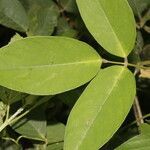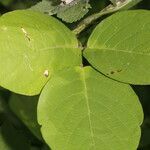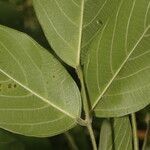Robust vine, stems terete, becoming somewhat woody, pilose with tan colored hairs, glabrescent. Leaves pinnate trifoliolate, the leaflets narrowly ovate, api-cally acute or slightly acuminate, mostly 8-13 cm long, 3-8 cm wide, basally rounded, papyraceous to subcoriaceous, glabrate on both sides or pubescent beneath; petiolules 3-5 mm long, stout; rachis and petioles drying grooved, pu-bescent; stipels linear subulate, about as long as the petiolules; stipules acute, nervate, 4-5 mm long. Inflorescences few flowered pseudoracemes, peduncles 2-6 cm long, the rachis thickened with conspicuous nodes, 2-3 cm long; bracts stipule-like; bracteoles ovate subspathaceous, ca. 10 mm long, ciliolate, glabrate, finely nervate, enclosing the calyx cup but not the longest tooth; pedicels 3-7 mm long, puberulent. Flowers pink and red within, green and pink outside; calyx cupular, the cup 3-4 mm long, the teeth dorsally pubescent, the longest 7-10 mm long, the others 4-5 mm long, the lower pair united about halfway up, the sinus acute; standard orbicular, ca. 3 mm long, puberulent dorsally. Fruit linear, mostly 15-20 cm long, 7-8 mm wide, compressed, smooth, the margins conspicuously thickened, ca. 2 mm wide, the beak 10-13 mm long, acicular, straight, glabrous; seeds dark brown, rectangular, 5-6 mm long, the hilum occupying one side.
More
A trailing herb. It has a taproot and slender stems. The young stems have greyish hairs. The leaves have 3 leaflets. The leaflets are oval. They are rounded at the base and taper at the tip. The central leaflet is largest and 8-13 cm long by 3-8 cm wide. The flowers are in groups in the axils of leaves. There can be 30 flowers in pairs. The petals are cream with a purple centre. The pod is 30 cm long and 1 cm wide. There are 25 seeds. They are 5 mm long by 3 mm wide. They are yellowish-brown.




